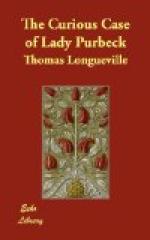In Laud’s Diary there is an entry: “1622, April 23. Being the Tuesday in Easter week, the King sent for me & set me into a course about the countess of Buckingham, who about that time was wavering in point of religion.” And again: “May 24. The conference[49] between Mr. Fisher [Percy] a Jesuit, & myself, before the lord Marquis of Buckingham, & the countess, his mother.”
There are people who are of opinion that for a Protestant to become a Catholic is an almost certain proof of madness; and such will rejoice to hear that, some time after Lord Purbeck had been received into the Catholic Church, he either showed, or is reputed to have shown, signs of lunacy.
Some authorities doubt whether Purbeck was ever out of his mind; but on the whole the weight of evidence is against them. Yet there are some rather unaccountable incidents in their favour. Again, when anybody is reputed to be mad, exaggerated stories of his doings are very likely to be spread about. Even in these days of advanced medical science, it is sometimes difficult to decide whether a patient is insane or not, and it is quite possible to suffer from very severe fits of depression without being the subject of maniacal melancholia, or from very violent fits of passion without being a madman.
There is just a possibility, too, that Buckingham may have wished to keep his brother quiet, or to get him out of the way, because that brother “would speake plaine English to him” about his licentious conduct and other matters, as we have already read. When a friend or a relative tells a man that he is behaving scandalously, the recipient of the information is apt to say that his informer is “cracked.”
The earliest hint of Lord Purbeck’s insanity was given in 1620. “The Lord Viscount Purbeck went abroad in the latter end of May 1620, under colour of drinking the waters of Spaw, but in fact, as Camden tells us, to hide his being run mad with pride."[50] The strongest evidence of anything like actual madness is in a letter[51] from Chamberlain to Carleton, written on 8th June, 1622. It may, however, be mere gossip. “The Lord of Purbecke is out of order likewise, for this day feurtnight getting into a roome next the street in Wallingford house, he beat down the glasse windowes with his bare fists and all bloudied &c.” If this be true, may it not be possible that he was trying to break his way out of a room in which Buckingham had locked him up on the pretence that he was insane? Of Wallingford House the same correspondent says in another letter: “Buckingham has bought Lord Wallingford’s house at Whitehall, by paying some money[52] making Sir Thomas Howard, Visct. Andover, and some say, releasing the Earl and Countess of Somerset.”
In August, 1623, the Duchess of Buckingham—this would be Buckingham’s wife and not his mother, the Countess of Buckingham—wrote to Conway:—
“SIR,[53]




